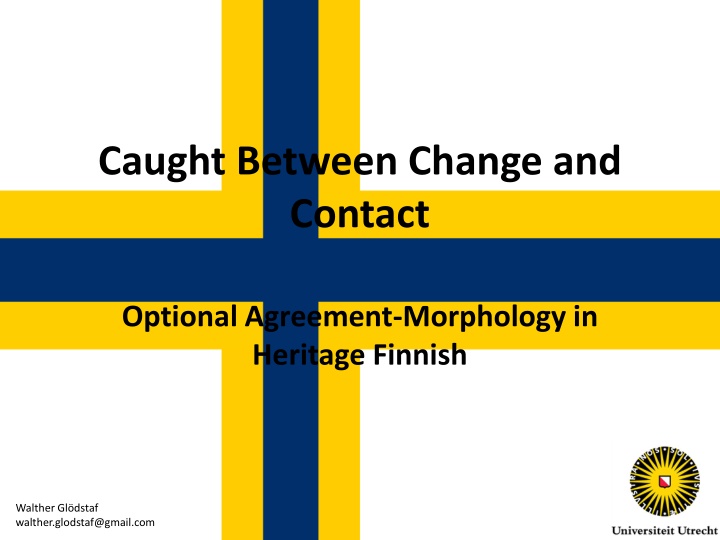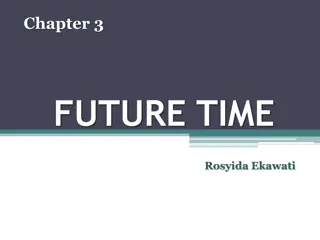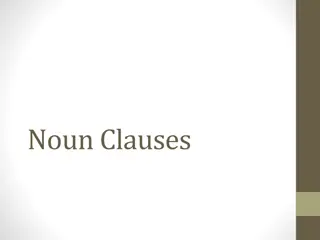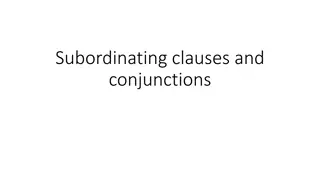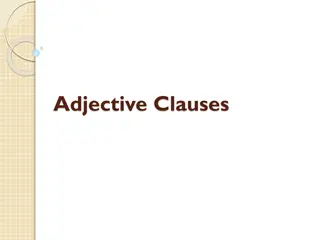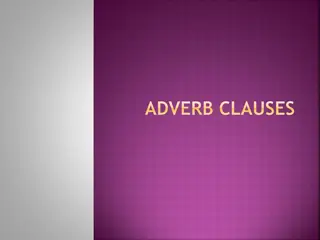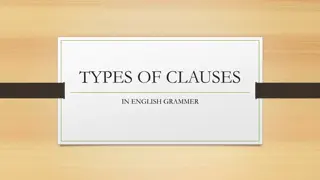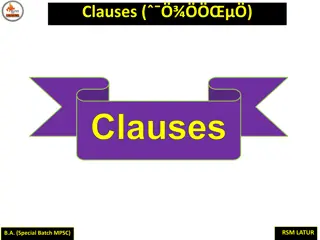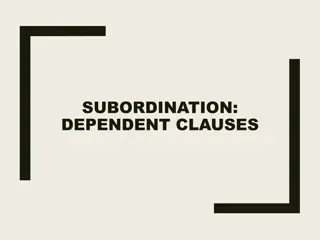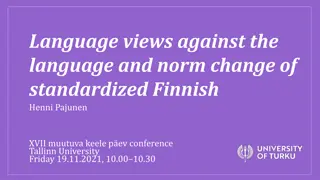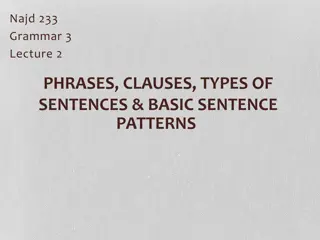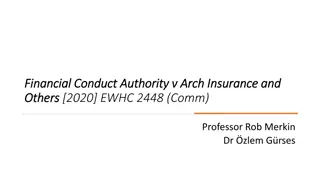Morphology and Optionality in Heritage Finnish Px Clauses
Explore the analysis of possessive suffixes (Px) in Finnish temporal adverbial clauses with a focus on optionality among Heritage Finnish speakers in different regions. Discover insights into refunctionalisation processes and the influence of language contact on change within loci. Definitions and characteristics of Heritage Finnish speakers, Finnish-Swedes, and Finns are examined as well.
Download Presentation

Please find below an Image/Link to download the presentation.
The content on the website is provided AS IS for your information and personal use only. It may not be sold, licensed, or shared on other websites without obtaining consent from the author.If you encounter any issues during the download, it is possible that the publisher has removed the file from their server.
You are allowed to download the files provided on this website for personal or commercial use, subject to the condition that they are used lawfully. All files are the property of their respective owners.
The content on the website is provided AS IS for your information and personal use only. It may not be sold, licensed, or shared on other websites without obtaining consent from the author.
E N D
Presentation Transcript
Caught Between Change and Contact Optional Agreement-Morphology in Heritage Finnish Walther Gl dstaf walther.glodstaf@gmail.com
Todays Menu Possessive suffixes (Px) in Finnish temporal adverbial clauses (glossed TUA) Results on Comparsion of Optionality of Px in Heritage Finnish in Sweden, Finnish and the Finnish of Finland-Swedes Analysis of results as a form of refunctionalisation (Haspelmath& Michaelis, 2017): Null subject of Adverbial becomes more anaphoric than pronominal Walther Gl dstaf (Universiteit Utrecht) walther.glodstaf@gmail.com
Central Message Loci of change seem independent of language contact (i.e. contact does not select what gets changed), BUT contact influences how the elements of a locus of change are changed. Walther Gl dstaf (Universiteit Utrecht) walther.glodstaf@gmail.com
Definitions: Populations Heritage Speakers: Speakers who have learnt Finnish as an L1 but grew up in Sweden or moved there as (young) adults (unbalanced bilinguals: dominant Language is Swedish) Finnish-Swedes: The Swedish speaking minority in Finland who are best characterised as early balanced bilinguals (simultaneous& sequential) Finns: Finnish native speakers with no real proficiency in Swedish Walther Gl dstaf (Universiteit Utrecht) walther.glodstaf@gmail.com 1
Definitions: Refunctionalisation Basically a process of Synthetic Analytic constructions (Haspelmath& Michaelis, 2017). Crucially, here treated as an information economy strategy where syntactic information is only encoded once instead of multiple times and encoding using discrete functional units ( words ) is favoured over indiscrete units ( affixes ). A process which is widespread with Px in nominal domains in Finnish and especially heritage Finnish in Gothenburg (Boyd& Andersson, 1991). Ex: Minun[1s] talo-ni[1s] Minun[1s] talo-ni[1S] I.GEN[1s] house-Px1S[1s] I.GEN[1s] house- Px1S[1S] My house. Walther Gl dstaf (Universiteit Utrecht) walther.glodstaf@gmail.com 2
Definitions: Possessive suffix Px is analysed as an agreement marker (often but not exclusively) for non-finite verbs and possessive constructions (Huhmarniemi& Brattico, 2015) It is licensed by an anaphoric null pronominal (van Steenbergen, 1991; Huhmarniemi& Brattico, 2015) The Px licensor has both anaphoric (PRO) and pronominal (pro) properties! Walther Gl dstaf (Universiteit Utrecht) walther.glodstaf@gmail.com 3
Describing the Px I A Px in Finnish is a morpheme that signals agreement between possessor and possession. (Minun) sormukse-ni (My.GEN) ring-Px1S My ring. Walther Gl dstaf (Universiteit Utrecht) walther.glodstaf@gmail.com 4
Describing the Px II Px is also used to mark agreement in infinitival or adverbial clauses between the verb and the null subject (indicated in brackets). Note the anaphoric nature of the NS when it is co-referenced with the matrix subject! Min 1 nukahd-i-n (*minun)1 n h-ty -ni I.NOM 1 fall-asleep-PAST-1S (*I.GEN) 1 see-TUA-Px1S elokuvan movie I fell asleep after seeing a/the movie. Walther Gl dstaf (Universiteit Utrecht) walther.glodstaf@gmail.com 5
Describing the Px III The Px cannot be covert when the subject of the adverbial is a null subject and bound by the matrix subject Min 1 nukahd-i-n 1 n h-ty -*(ni) elokuvan I.NOM 1 fall-asleep-PAST-1S 1 see-TUA-*(Px1S) movie I fell asleep after seeing a/the movie. Min nukahd-i-n sinun n h-ty (-si) elokuvan I.NOMfall-asleep-PAST-1S you.GEN see-TUA(-Px2S) movie I fell asleep after you saw a/the movie. Px is optionally covert, when the null subject is an overt pronominal Min nukahd-i-n Antin n h-ty -*n I.NOMfall-asleep-PAST-1S Antti.GEN see-TUA-*Px3 movie I fell asleep after Antti saw a/the movie. Px is obligatorily covert if the adverbial s subject is a DP elokuvan Walther Gl dstaf (Universiteit Utrecht) walther.glodstaf@gmail.com 6
More constructions with Px Frodo toivoi muutta-va-nsa Bukinpur-iin pian Frodo hoped.3S move-VA-Px3 Buckelbury-ILL soon Frodo hoped to move to Bucklebury soon. Frodo meni Mordoriin tuhoa-ksee-nsa sormuksen Frodo went.3S Mordor-ILL destroy-KSE-Px3 ring Frodo went to Mordor in order to destroy the ring. Eowyni-sta tuli sankari kukistamallaa-n Nazg lin. Eowyn-ELA became.3S hero vanquish-MA-Px3 Nazg l Eowyn became a hero by vanquishing a/the Nazg l. Walther Gl dstaf (Universiteit Utrecht) walther.glodstaf@gmail.com 7
Px in Standard Finnish If the pronominal that licenses Px is null, the Px must be overt If the pronominal is overt Px can optionally be covert If the Px would refer to an overt full DP the Px must be covert Walther Gl dstaf (Universiteit Utrecht) walther.glodstaf@gmail.com 8
Px in Heritage Finnish I The Px is optionally covert when the subject of the adverbial is a null subject and bound by the matrix subject Min 1 nukahd-i-n 1 n h-ty -(ni) elokuvan I.NOM 1 fall-asleep-PAST-1S 1 see-TUA-(Px1S) movie I fell asleep after seeing a/the movie. Min nukahd-i-n sinun n h-ty (-si) elokuvan I.NOMfall-asleep-PAST-1S you.GEN see-TUA(-Px2S) movie I fell asleep after you saw a/the movie. Px is optionally covert, when the null subject is an overt pronominal Min nukahd-i-n Antin n h-ty -*n I.NOMfall-asleep-PAST-1S Antti.GEN see-TUA-*Px3 movie I fell asleep after Antti saw a/the movie. Px is obligatorily covert if the adverbial s subject is a DP elokuvan Walther Gl dstaf (Universiteit Utrecht) walther.glodstaf@gmail.com 9
Px in Heritage Finnish II If the pronominal that licenses Px is null, the Px can optionally be covert If the pronominal is overt Px can optionally be covert If the Px would refer to an overt full DP the Px must be covert Walther Gl dstaf (Universiteit Utrecht) walther.glodstaf@gmail.com 10
Summary on Covertness of Px Px Status Covert Overt Subject Heritage Standard Heritage Standard Null-pronominal Overt pronominal Yes Yes No Yes Yes Yes (hypercorrect) Yes Yes (hypercorrect) Non-pronominal No No No No Why is there a change in the heritage language and is it due to contact or change? Walther Gl dstaf (Universiteit Utrecht) walther.glodstaf@gmail.com 11
The Experiment Elicitation experiment with heritage, Finnish and Swedish-Finnish speakers of Finnish. Participants were presented question answer pairs where they had to repeat the answer Answers had a mistake either by having a semantically wrong adverbial or a correct adverbial but wrong direct object Case Overtness/Covertness of Px also varied Walther Gl dstaf (Universiteit Utrecht) walther.glodstaf@gmail.com 12
Participants 7 Heritage speakers of different ages late 20s 60 from Stockholm. Either first or second generation with the shortest time lived in Sweden being 10 years 7 Finnish-Swedes between 20 70 eithe early simultaneous of sequential balanced bilingualsm from Helsinki 7 Finns aged 20-30 (due to phenomenon being more present among younger speakers) from Helsinki All participants had some experience with tertiary education; ergo highly literate, though socio-economic family backgrounds ranged from blue- to white-collar families. Walther Gl dstaf (Universiteit Utrecht) walther.glodstaf@gmail.com 13
Sample Stimuli Q:Milloin Esan vanhemmat muutti Helsinkiin? When did Esa sparents move to Helsinki? A:Esan vanhemmat muutti Helsinkiin Esa s parents moved Helsinki.ILL #valmistel-tua- opiskelut #prepare-TUA- studies Esas parents moved to Helsinki after #prepairing their studies (meant: finishing) (Valmisteltua vs valmistuttua) Walther Gl dstaf (Universiteit Utrecht) walther.glodstaf@gmail.com 14
PX Elicitation Data Covert Px Overt Px Finnish- Swedes Finnish- Swedes Group Heritage Finnish Heritage Finnish Ratio per Type 8:15 3:12 3:10 13:29 31:48 22:30 Total Average Median 23 3,83 3 15 2,14 2 13 1,86 2 42 7 6 79 52 7,43 7 11,29 12 Percent 35% 16% 20% 65% 84% 80% Percent contra S 35% 20% 23% 31% 39% 42% Percent like S 65% 80% 77% 69% 61% 58% 15
Covert Px Explanations Heritage Finnish-Swedes Finnish Explanation 7 (0:7) 8 (0:8) 7 (0:7) Overt Subject 3 (3:0) 0 (0:0) 3 (1:2) DO in Non-Subject Case 13 (5:8) 7 (3:4) 3(2:1) Neither 16
Percent of Covert PX Type per Explanation Heritage Finnish-Swedes Finnish % % Contra S % Like S % % Contra S % Like S % % % Like S Explan ation Total Total Total Contra S 30,43 0 100 53,33 0 100 53,85 0 100 Overt Subject DO in Non- Subject Case 13,04 100 0 0 0 0 23,08 33 66 Neither56,52 38,46 61,54 46,66 42,86 57,14 23,08 66 33 17
Results: Summary Heritage speakers accepted covert Px and even produced it contra stimuli, while Finnish- Swedes and Finns largely did not Both Heritage speakers and Finnish-Swedes accept and produce covert Px with a null pronominal subject, though heritage speakers do this more Walther Gl dstaf (Universiteit Utrecht) walther.glodstaf@gmail.com 18
Analysis Co-occurrence of covert Px and subject of the adverbial could be explained by refunctionalisation . The Px is allowed to be covert as the phi-information of the null subject is already being expressed through it being anaphoric to the matrix subject. This however seems not to be triggered by contact, age, length of stay in Sweden etc. When there is a null subject it is more easily accessible as a PRO when Finnish is in contact with Swedish due to Swedish having PRO but lacking pro (also suggested by Case assignment data, where pre-verbal objects cause garden path effects for Finns and only sometimes do so for with Swedish Finns and never with heritage speakers) Walther Gl dstaf (Universiteit Utrecht) walther.glodstaf@gmail.com 19
Analysis What to do about the 1:2 ratio of covert vs overt Px? Answer: Multiple Grammars (Tortora, 2014); one heritage that allows for optionality of covert/overt Px and one standard that disallows it Assuming each grammar has a 50% chance of being chosen and optionality means a 50% chance of a covert Px occuring (na ve view), then we d have a 1 :2 ratio of covert to overt Px Walther Gl dstaf (Universiteit Utrecht) walther.glodstaf@gmail.com 20
Conclusion Loci of change seem independent of language contact (i.e. contact does not select what gets changed), BUT contact influences how the elements of a locus of change are changed. Walther Gl dstaf (Universiteit Utrecht) walther.glodstaf@gmail.com 21
References Boyd, S., Andersson, P., 1991. Linguistic change among bilingual speakers of Finnish and American English in Sweden: Background and some tentative findings. International Journal of The Sociology of Language, pp. 13-36. Brattico, P. 2014. Long Distance Case Assignment and Intervention. Lingua 148, pp. 309-336 Brattico, P. 2017. Control and Null Subjects Are Governed by Morphosyntax in Finnish. Finno-Ugric Languages and Linguistics 6 (2), pp. 2-37. Brattico, P., 2018. Finnish topicalization is not about the topic. Talk at: IUSS, Pavia 10/17/18. Retrieved from: https://www.academia.edu/37609834/Finnish_topicalization_is_not_about_the_topic (Retrieved: 05/04/18) Benmamoun, E., Montrul, S., & Polinsky, M., 2013. Heritage Languages and Their Speakers: Opportunities and Challenges for Linguistics. Theoretical Linguistcs 39, pp. 129-181. Haspelmath, M., 2011. The indeterminacy of word segmentation and the nature of morphology and syntax. Folia Linguistica 45 (1), pp. 31 80. Haspelmath, M., & Michaelis, S., M., 2017. Analytic and synthetic: Typological change in varieties of European languages. In: Buschstaller, I., & Siebenhaar, B. (Eds.), Language Variation European Perspectives VI: Selected papers from the 8th International Conference on Language Variation in Europe (ICLaVE 8), Leipzig 2015, Amsterdam: Benjamins, pp. 3-22. Huhmarniemi, S., & Brattico, P., 2015. The Finnish possessive suffix. Finno-Ugric Languages and Linguistics 4 (1-2), pp. 2-41. Steenbergen, M. van, 1991. Long-distance binding in Finnish. In J.Koster & E.J. Reuland (eds.).Long-distance anaphors. 231 244. Cambridge: Cambridge University Press Tortora, C., 2014. Addressing the Problem of Intra-speaker Variation for Parametric Theory. In: Zanuttini, R., & Horn, L., R. (Eds.), Micro-Syntactic Variation in North American English. New York: Oxford University Press, pp. 294-323 Walther Gl dstaf (Universiteit Utrecht) walther.glodstaf@gmail.com
Walther Gldstaf (Universiteit Utrecht) walther.glodstaf@gmail.com
